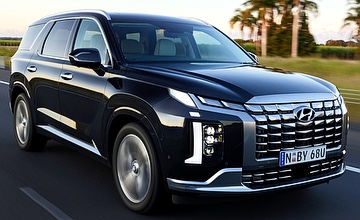OptionsCar reviews - Hyundai - PalisadeHyundai modelsOverviewHyundai finesses the Palisade with a rationalised range, more gear and improved refinement12 Aug 2022 By TONY O'KANE IF EVER there was a car that was in immediate need of a facelift upon launching, the Hyundai Palisade was it.
Launched locally at the end of 2020, the Palisade had already been out overseas for two full years at that point. While its big broad-shouldered large SUV wagon body-styling was generally handsome, it looked a little old-fashioned by the time it got here, especially considering it was sharing showroom floor space with the i30 Sedan and, not long after, the all-new Tucson – both prime examples of Hyundai’s latest design language.
There’s only so much that can be done during a mid-cycle facelift, but Hyundai’s exterior designers have waved their styluses to great effect here. Bumper plastics, grilles, wheels and lamp clusters are the only exterior items to get major changes, but the new grille and front bumper design proves to be vehicular Botox for the Palisade’s face – and we mean that in the most complimentary way.
Gone is the old Hyundai grille graphic, replaced by a T-shaped aperture with large rectangular blocks in the place of more conventional plastic mesh, and which also appear to extend into the upper headlamp housings – but are really cleverly-camouflaged LED indicator modules.
On the top-spec Highlander, the grille plastics gain satin-chrome appliques for an extra layer of aesthetic sophistication, and the sum of the cosmetic changes imparts a thicker layer of polish and a dash of panache to the Palisade’s visual posture.
But that’s literally a skin-deep analysis. The bulk of the mid-cycle updates that have been applied to the Palisade go much deeper – and while many will be invisible to the average punter, their effect would arguably be quite obvious if they had any extensive experience of the pre-update model.
We’ve highlighted the full list of changes in our product story here, but the key takeaways are this: a suspension retune that brings new damper technology; significantly more noise, vibration and harshness suppression via more sound deadening, revised suspension bushings and thicker window glass; new safety gear and structural reinforcements that bring an upgrade in ANCAP rating to a full five stars from the previous model’s four; the first application of Hyundai’s Bluelink telematics and remote-access technology; new interior trims and upholstery; and a bevy of incremental infotainment and quality-of-life upgrades.
Plenty of stuff to fill out the brochure, then – and justify the markup over the pre-update Palisade, which ranges from an extra $3700 for the Elite AWD and 2WD, and $5009 for the Highlander diesel AWD. How about the base model? Well, that no longer exists, with Hyundai Motor Company Australia (HMCA) citing ultra-low uptake of that model (a mere six percent of the total mix) as the reason for its culling. That means the Palisade now starts at $65,900 for the Elite 2WD petrol and caps off at $79,900 for the Highlander AWD diesel, which puts the Palisade firmly in near-premium territory.
So, is it qualified to be knocking on the door of premium marques, and potentially stealing some buyers that would otherwise be looking at mid-size SUV options from The Germans?
Well, it certainly makes a positive first impression. With its confident new look, the Palisade has enough road presence to attract the eye. Stepping inside there’s a lot of familiar furniture, but the updated trimmings and new leather upholstery (finer-grade Nappa in the Highlander) with its elegant quilting both do their bit to lift the ambience – the microsuede headliner and stainless steel speaker grilles of the Highlander grade certainly go the extra mile in that regard, too.
The steering wheel is new, sporting a four-spoke config versus the three-spoker of the old model, while the dashboard’s beltline now features a slim recess that ties the centre and passenger side air vents together into one contiguous unit – and is topped by a leather-trimmed pad, no less.
The twin-screen dash with its 12.3-inch infotainment display and 12.3-inch instrument panel are a step up on the 10.25-inch infotainment and puny 7.0-inch MFD/analogue dial combo of the pre-update model, and there’s even changes to the wireless phone charging pad in the centre console: now equipped with a cooling fan, it can jam electrons into your smartphone at a faster rate than before.
The rest of the in-car experience is largely the same, but it was already fit for purpose to begin with. There’s still that useful flying-buttress centre console with its floor-level storage shelf; a commodious lidded centre box, plenty of USB charge ports through the cabin; roof vents for all back-seaters (including the third row); one-touch electronic releases for the second row seats to enable easy access to the third row, plus the retention of the seven-seat option that puts a gap between the second-row captain’s chairs that an adult can pass through.
For those with BIG families, the eight seat configuration remains a no-cost option, and all rows will easily accommodate adults (though three across the third row would be challenging.
We’ll have to properly road-test those back seats at a later date, but from the front seat the 2023 Palisade hits the mark.
 Read more9th of August 2022  No hybrid on horizon for Hyundai PalisadePalisade continues on a combustion path as other Hyundai models get electrified |
OptionsClick to share
|
















Facebook Twitter Instagram